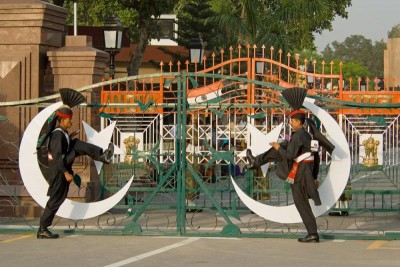By Ayesha Siddiqa
MONDAY night is sure to have caused anxiety and excitement among certain sections of those who received the news of India’s launch of its first indigenous nuclear submarine.
The Foreign Office denounced the development as something that could start a nuclear-arms race in the region, and Defence Minister Ahmed Mukhtar awoke from his slumber and lambasted the Indians.
The Pakistan Navy’s admirals spoke about the need to respond. The question is: will the launch really trigger a nuclear-arms race in the region and destabilise Pakistan’s security?
First, the term ‘nuclear submarine’ does not mean a submarine loaded with nuclear weapons. In fact, it would be appropriate to say a ‘nuclear-powered’ submarine that can stay submerged for a longer period of time. This capability alone makes a nuclear submarine an extremely lethal weapon because it could sneak beneath a country’s territorial waters and fire a conventional or nuclear warhead. Also, since they are longer, nuclear subs can carry larger torpedo tubes that are useful for firing nuclear warheads.
India’s launch shouldn’t come as a surprise because New Delhi had been working on this project since the end of the 1980s when it had hired a Charlie-class Soviet nuclear-powered sub. This was basically to familiarise itself with the use of a nuclear sub. Even at that time, senior officers in Pakistan were upset and desirous of obtaining similar technology for Pakistan. Luckily, we did not embark upon an expensive project. Later, during the 1990s, the Indian Navy exercised with the Israeli Navy in the Indian Ocean practising on Israel’s Scorpene subs of French origin, learning how to fire nuclear warheads from conventional subs.
We don’t need to copy the Indians because the Pakistan Navy already has the French Agosta 90B subs with an air-independent propulsion system that allows it to remain submerged for longer periods than the older subs. This means that if the navy could miniaturise nuclear warheads, it could sneak into Indian waters with the Agosta 90B at a time of extreme crisis and threaten the Indians. Technically speaking, the job is done. Now, we don’t have to follow the Indians who probably wanted the new submarine for a feel-good effect and to join the league of the ‘bigger boys’ including China, the US, Britain and France.
The real danger of the launch of a nuclear submarine by India is that it might force us to follow suit. If our admirals close their eyes they might just see their counterparts sticking out their tongues at them. This could prove to be a dangerous bait and bleed us financially. A nuclear submarine is an extremely expensive project. The Indians have managed to do it because they had more cash and a lot of Russian help. Pakistan, that had toyed with the idea of hiring nuclear submarines during the 1980s in response to India’s action and had failed to get one, might want to buy one from China. It does not seem likely that Beijing would give this technology to Pakistan at this stage.
An arms race is not the best formula for Pakistan. We will probably want to force ourselves to acquire this or that technology within a short span of time. There are two possible options. First, we could covertly
buy the technology from someone and end up with the kind of bargain we did with North Korea — this might give us a bloody nose. The second would be to start on an indigenous product.
Although we secretly claim to have the capability to adapt our Agosta 90Bs to carry nuclear warheads, the French designers deny that we have the capacity to alter the basic design of the torpedo tube. But this might just be the extent of our naval engineering work. Despite our claims to have made the Agosta 90B subs under a transfer-of-technology deal with the French, our agreement with Paris for the subs and the mine-hunters was so wishy-washy that we really cannot go beyond assembling these naval platforms or integrating the systems on these machines.
This is one of the basic steps in the development of indigenous production. We have never gone any further due to a lack of research and development, the absence of offset arrangements with original weapons manufacturers and a weak vendor industry. The defence industry, which is in the public sector, and its vendors, who are mostly private entrepreneurs, represent two diverse cultures. Mainly due to organisational-cultural problems there has never been a healthy interface to allow the public-private defence industry to carry out value-added work.
In comparative terms, the Pakistan Ordnance Factories and the Heavy Industries Taxila have taken bigger strides. But this is also because the technology is less complex than what the air force and navy require. The Pakistan Aeronautical Complex was catching up a few years ago when it had signed an offset agreement with Boeing. However, there are problems in its Karakoram-8 and JF-17 Thunder co-development, co-production contract that must be eradicated if the air force is to get maximum benefit. The navy lags behind.
Indeed, if any lesson is to be drawn from the Indian nuclear sub launch it is that Pakistan must revamp its entire defence production policy that rarely gets attention because those at the top are interested in buying weapons off-the-shelf. We have to develop our engineering and technology base, which in turn means greater education. And better education will mean setting our priorities straight. (One is reminded of a poster inscribed with the hope that a day would come when schools would have ample money and the air force would have to hold a bake sale to buy a bomber.)
In the meantime, let’s leave the nuclear-powered sub competition to China. In any case, having acquired an indigenous nuclear-sub-building technology India has not really acted wisely, for this has been at the cost of millions of dispossessed and hungry. Why would we want to take that route?
The writer is an independent strategic and political analyst.
-Source: DAWN-










The writer is making a very sensible point by stating that Pakistan should not try to match everything India does in the field of defense, and hope the establishment in Pakistan pay attention to this point. What Pakistan need is more emphasis on science, math and engineering education at all levels from A to Z and less state sponsored religious teaching.